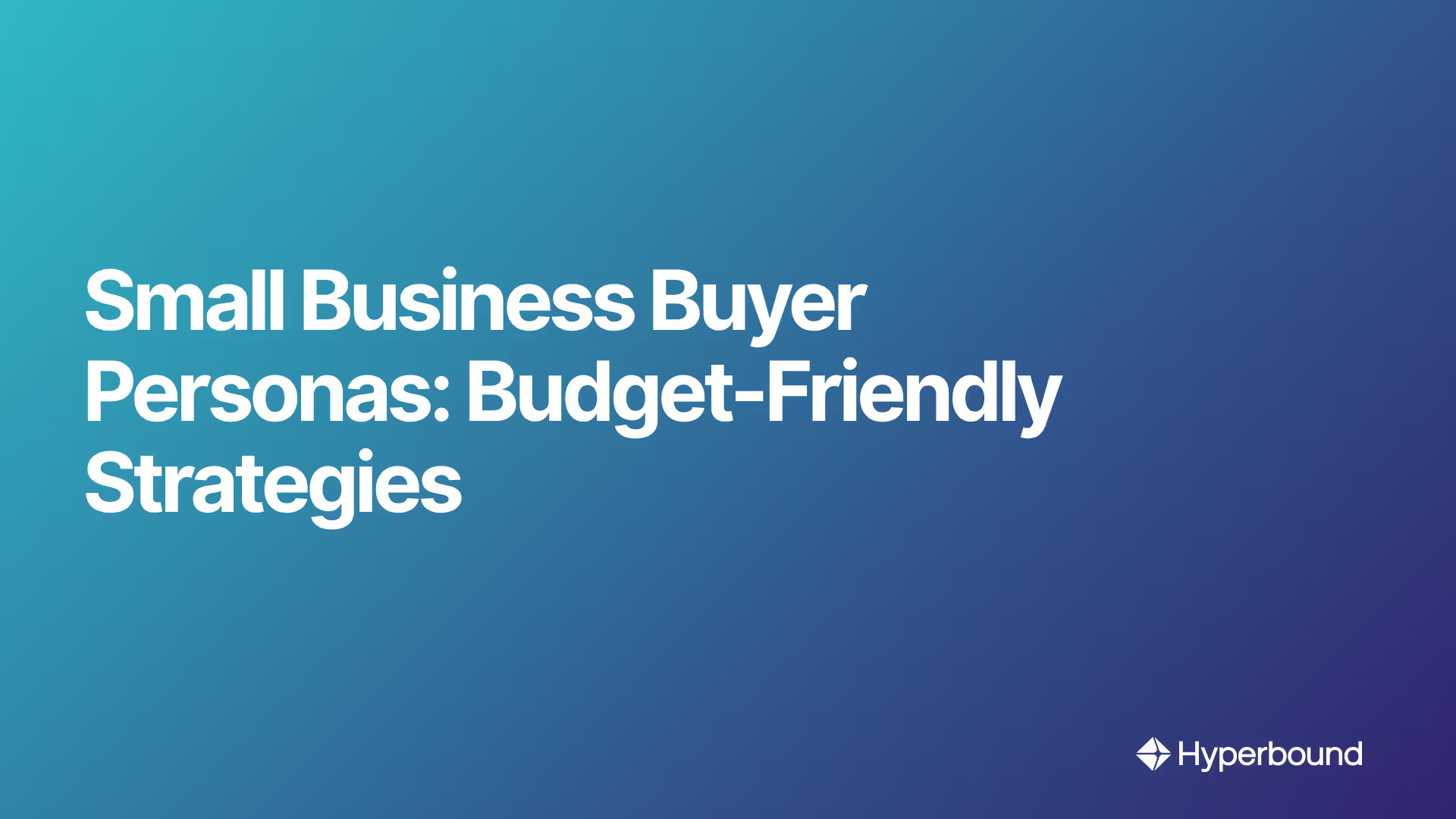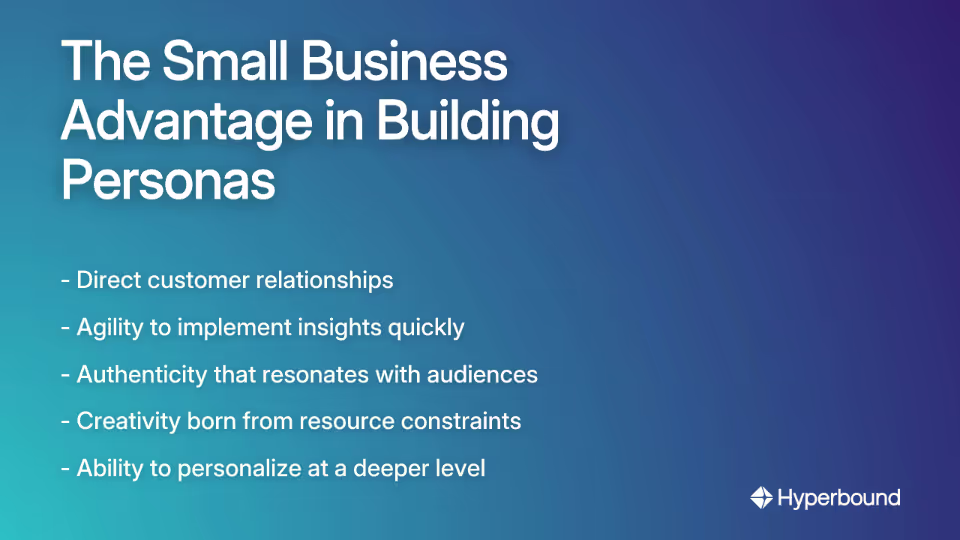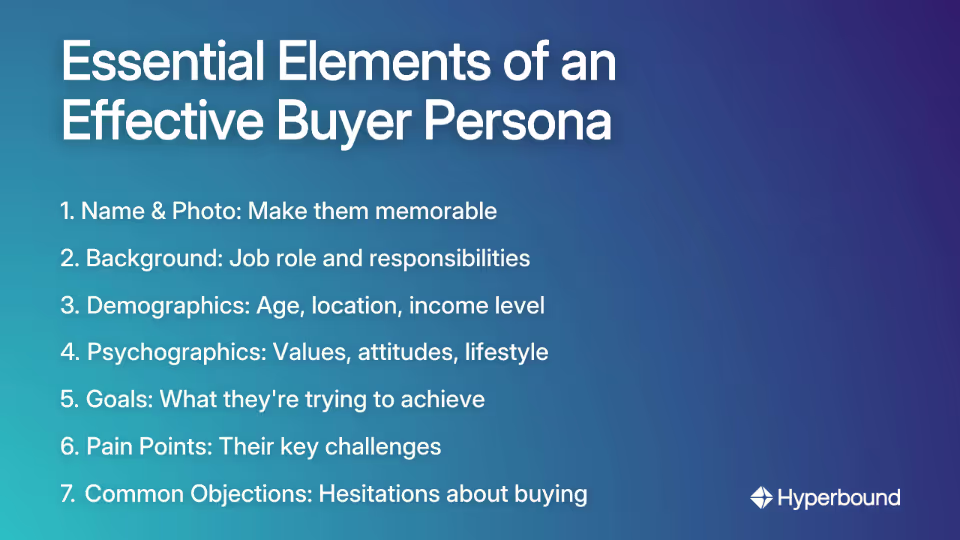
You stare at your computer screen, scrolling through yet another article about "creating effective buyer personas" that recommends hiring market research firms, conducting extensive focus groups, and investing in sophisticated analytics tools. The frustration builds as you mentally calculate your small business marketing budget—which wouldn't cover even a fraction of what they're suggesting.
Sound familiar? You're told you need buyer personas to succeed, but the methods you hear about seem designed exclusively for corporations with bottomless resources. As one small business owner put it, "Market research can be expensive," and when you're working with a limited budget, that can feel like a non-starter.
Let's be honest—sometimes you might wonder if "most companies make that shit up anyway." The good news? You don't need a Fortune 500 budget to create powerful, actionable buyer personas that drive real results.
This article will deconstruct the expensive "ivory tower" methods of large corporations and contrast them with the scrappy, high-impact "small biz hustle" tactics that leverage your greatest assets: creativity, agility, and direct customer connection.

What's a Buyer Persona, Really?
Before diving in, let's clarify: a buyer persona is a semi-fictional representation of your ideal customer based on market research and real data about your existing customers. It goes beyond basic demographics to include behaviors, motivations, goals, and pain points—essentially creating a profile that helps you understand and connect with your target audience.
The Ivory Tower: How Big Companies Build Personas with Big Budgets
Large corporations approach buyer personas with resources most small businesses can only dream about. Understanding their methods helps illustrate why the "small biz hustle" is not just different, but in many ways, more advantageous.
Outsourcing to Specialized Agencies
Fortune 500 companies regularly hire specialized market research firms to conduct comprehensive studies. These agencies run professional focus groups, distribute large-scale quantitative research surveys, and conduct one-on-one interviews to gather qualitative data. This outsourced approach can cost anywhere from tens to hundreds of thousands of dollars.
Leveraging Big Data & Advanced Analytics
Large enterprises have access to vast datasets from sophisticated CRM platforms, consumer behavior studies, and economic trend analyses. They invest heavily in technology for look-alike audience modeling and deep segmentation. Their marketing departments might employ dedicated data scientists to process and interpret this information, creating intricate customer profiles based on thousands of data points.
Saturation Marketing & Experimentation
Perhaps the most significant advantage of big budgets is the ability to experiment freely. As one marketer observed, "larger companies can afford to experiment and fail until they succeed." They can test different messages across multiple channels simultaneously, analyzing results and optimizing their approach without worrying about depleting their marketing budget.
The Potential Downside
Interestingly, big budgets aren't always better. As one marketing professional noted, "With a big budget, there's less pressure, which sometimes means people get comfortable with mediocrity." Additionally, corporate research can become so abstract that it's merely "descriptive and not predictive," losing its practical edge for creative and sales teams who need actionable insights.
The distance between corporate decision-makers and actual customers can also result in personas based more on assumptions than reality—regardless of how much money was spent collecting data.
The Small Biz Hustle: High-Impact Personas on a Shoestring Budget
Now for the good part—how you can create powerful buyer personas without the corporate expense account. The small business approach requires a mindset shift: instead of broad market research, you need laser-focused insights.
Mindset Shift: From Broad Research to Laser-Focused Insight
As one savvy business owner put it, "I would want to leverage any and all information I already have." Your goal isn't to find every possible customer; it's to find more people like your best customers. This targeted approach is actually more efficient and effective than casting a wide net.
Step 1: Dig for Gold in Your Own Backyard (Leverage Existing First-Party Data)
Small businesses often struggle to gather first-party data due to resource constraints—but here's the secret: you already have it.
- Sales Records & CRM Data: Even if your "CRM" is just a spreadsheet, it contains gold. Who are your repeat customers? What do they buy most frequently? Where are they located? Look for patterns in your existing customer base.
- Website Analytics: Use free tools like Google Analytics to understand who's visiting your site. Look at Audience > Demographics and Interests to get insights into age, gender, and topics your visitors care about. Check the Acquisition section to see how people find you—are they coming through organic traffic from search engines or social media?
- Social Media Insights: The free analytics available on platforms like Facebook, Instagram, or Twitter can reveal valuable demographic and psychographic information. Which posts get the most engagement? Who's following and interacting with your content? This is simple but effective social media marketing research.
Step 2: The Power of a Simple Conversation (Direct Customer Feedback)
Here's where small businesses have a major advantage over corporations: direct access to customers. While the CMO of a Fortune 500 company might never speak directly to an actual customer, you probably interact with yours regularly.
Turn these interactions into qualitative data gathering opportunities:
- Conduct informal interviews: Ask open-ended questions like "What was going on in your business that led you to look for a solution like ours?" or "What were your biggest concerns before buying?"
- Talk to a variety of customers: Speak with your biggest fans and customers who seemed unhappy to get a balanced perspective. Tools like SurveyMonkey or Dovetail can help organize your findings, but even a simple note-taking app works.
- Listen for the language they use: Pay attention to the exact words and phrases they use to describe their problems. This verbatim language is marketing gold. For sales teams, AI platforms like Hyperbound's Real Call Scoring can analyze your actual customer conversations to automatically surface the language and talk tracks that resonate most.
Step 3: Scrappy Research with Free Public Data
Supplement your own findings with authoritative data that's completely free:
- Demographics: The U.S. Census Bureau offers detailed population, income, and location data that can help validate your assumptions.
- Employment & Economic Data: The Bureau of Labor Statistics provides industry trends and consumer spending habits through the Consumer Price Index.
- Low-Cost Survey Tools: Use Google Forms or a free SurveyMonkey plan to poll your email list or social followers about their challenges and goals. Even a simple five-question survey can yield valuable insights about your customers' purchasing influencers and decision-making process.
Step 4: Assembling Your Persona Profile

Now it's time to organize all this qualitative data and quantitative research into a usable document:
- Name & Photo: Give your persona a name and find a representative image to make them feel real to your team. "Small Business Owner Sarah" is more memorable than "Female, 35-44, $75K income."
- Background: Include job role, industry, and key responsibilities.
- Demographics: Age range, location, income level, education, etc.
- Psychographics: Values, interests, attitudes, and lifestyle factors that influence their decisions.
- Goals: What are they trying to achieve? (e.g., "Increase online visibility," "Find a trusted marketing advisor")
- Pain Points/Challenges: What frustrates them? What problems are they trying to solve? (e.g., "Lack of time for marketing," "Overwhelmed by digital marketing complexity")
- Common Objections: Why might they hesitate to buy from you? (e.g., "Distrust of agencies due to past failures," "Concerned about ROI")
HubSpot offers a free Make My Persona tool or downloadable persona templates that can help you organize this information professionally without any design skills.
Putting Your Persona to Work: From Profile to Profit
Creating buyer personas is only valuable if you actually use them. This is where small businesses often outshine larger corporations—by quickly putting insights into action across the entire customer journey.
Content & Social Media Marketing
Tailor your blog posts, videos, and social updates to directly address your persona's pain points and goals. If "Small Business Owner Sarah" is overwhelmed by digital marketing complexity, create content like "5 Simple Marketing Tasks You Can Do in 15 Minutes Each Morning."
Use the exact language your customers used in their feedback—this authentic voice will resonate more powerfully than corporate jargon. When your content speaks directly to your audience's needs, they'll wonder how you managed to read their minds.
SEO & Organic Traffic
Optimize your website for keywords your persona would actually use when searching. A local service business should focus on local SEO terms like "[service] near me" or neighborhood-specific phrases. This targeted approach ensures the right people find you, even with a modest digital marketing budget.
Remember that search intent matters as much as the keywords themselves. Your persona research should reveal whether your customers are searching for educational content, comparisons, or ready-to-buy solutions.
Email Marketing & Lead Nurturing
Craft email sequences that speak to your persona's specific stage in the customer journey. Nurture leads by sending helpful content that addresses their common objections and demonstrates your understanding of their challenges.
Email marketing consistently delivers one of the highest returns on investment in business marketing—making it perfect for budget-conscious small businesses. Your persona insights allow you to segment your email list and deliver more relevant, engaging content.

Website Design & User Experience
Design your website's navigation and calls-to-action to provide an intuitive path for your personas. Consider the questions they might have at each stage of their journey and make sure your site answers those questions clearly.
Your persona research might reveal that certain demographics prefer mobile browsing, while others typically visit from desktop computers. These insights can guide responsive design decisions that improve user experience across all devices.
Your Hustle is Your Unfair Advantage
A small marketing budget doesn't limit your ability to understand your customer—it forces you to be more creative and authentic. As one marketer put it, "You end up having to get creative to reach the broadest audience possible on the lowest budget."
This creativity often leads to more genuine connections. Your closeness to your customers is an advantage that large corporations spend millions trying to replicate with data. The "small biz hustle" allows you to build real relationships and gather insights that are far more powerful than any generic market research report.
Remember that personalized marketing strategies using buyer personas can increase effectiveness by up to 215% according to HubSpot research. Your scrappy approach may actually give you an edge over competitors who rely on outdated, expensive research methods.

Start Small, Think Big
Don't get overwhelmed by the process. Start small:
- Interview one customer this week
- Look at your existing sales data
- Create a simple persona template
- Apply those insights to one piece of marketing content
Remember that buyer personas are living documents. Revisit and update them at least once a year, or whenever you notice a shift in your customer base. The beauty of the small business approach is that you can quickly adapt as you learn more about your audience.
Your limited budget isn't a liability—it's the catalyst that drives the creativity, authenticity, and direct customer connection that big companies can only dream about. Embrace the hustle, and watch your marketing transform from generic to genuinely effective.
Frequently Asked Questions
What is a buyer persona and why is it important?
A buyer persona is a detailed, semi-fictional profile of your ideal customer based on real data. It is important because it helps you understand your customers' needs, motivations, and challenges, allowing you to create more effective marketing and sales strategies that resonate with the people most likely to buy from you.
How can I create a buyer persona with no budget?
You can create a buyer persona with no budget by leveraging free, existing resources. Start by analyzing your own first-party data from sales records and website analytics, conduct informal interviews with current customers to gather qualitative insights, and use free public data from sources like the U.S. Census Bureau to round out your profile.
How many buyer personas does a small business need?
A small business should start with just one or two buyer personas. It is more effective to have a deep, actionable understanding of your primary customer type than to create several shallow profiles. You can always develop more personas later as your business grows and diversifies.
What's the difference between a buyer persona and a target audience?
A target audience is a broad description of a group of people (e.g., "women aged 25-40"), while a buyer persona is a specific, detailed profile of a single ideal customer within that group. The persona brings the audience to life with a name, goals, and pain points, making it easier to create truly personal and relevant marketing.
How do I use a buyer persona in my marketing?
You use a buyer persona to guide every aspect of your marketing strategy. It helps you tailor your content, choose the right SEO keywords, craft relevant email campaigns, and design a user-friendly website. Essentially, the persona acts as a compass to ensure all your marketing efforts directly address your ideal customer's needs.
How often should I update my buyer personas?
You should review and update your buyer personas at least once a year, or whenever you notice a significant shift in your customer base or market. Personas are living documents that should evolve as your business and customers do, ensuring your marketing stays relevant and effective.
Book a demo with Hyperbound
.png)













